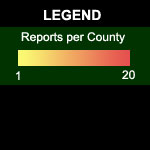Note: There are many more Ohio reports known to Ohio BFRO
investigators than appear in this database. There are a few reasons why the
other reports are not also included. The BFRO, as a general rule, only posts
first-hand reports to the online database. The exceptions are when a report is
published in a newspaper or when a second-hand report (a report written by
someone who the witness spoke with) also includes the contact information for the
witness. Most of the reports on the database come from witnesses who submit them
directly to the BFRO via the Internet. The remaining body of second-, third-, and
fourth-hand reports, etc., are not considered reliable enough to post online,
because, at best, they derive from sources that cannot be easily traced and are
therefore very likely to be substantially altered.
Direct contact between witnesses and the BFRO helps us to ensure
the basic integrity of our information. It also allows for further interviews
and incident-related data to be collected at a later time.
A side effect of our inclusion criteria is that certain areas with lots of
historical activity may be greatly under-represented on the database. This is
particularly evident in certain counties in eastern Ohio, western Pennsylvania,
and West Virginia where Internet access is spotty at best, and relatively few
people own computers. As Internet access penetrates deeper into these rural
areas, and computer prices fall, more historical information will trickle from
these areas and hopefully show a more accurate picture of where humans have been
crossing paths with these animals.
 |





















